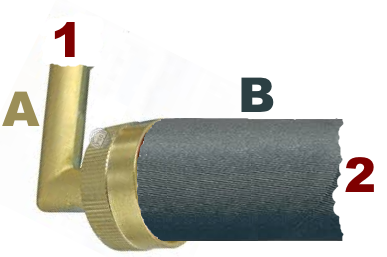






A evacuates water with a rate of $1\frac{L}{s}$ B with a rate of $5\frac{L}{s}$ Case A: - The valve is opened on the side 1: The water will be through A with a rate of $1\frac{L}{s}$, while passing quickly through B it will necessarily have in 2 the same rate as in A! Case B: - The valve is opened on the side 2: The water will first come quickly through B, but soon it will stagnate (equilibrium!) and can go through A only with $1\frac{L}{s}$, rate that it will inevitably have in 2!
The reaction (r) $NO_2$ $+$ $F_2$ $\longrightarrow$ $2NO_2F$ proceeds by two elementary steps (simple collisions): (a) $NO_2$ $+$ $F_2$ $\longrightarrow$ $NO_2F$ $+$ $F\cdot$ $v_a=k_a[NO_2][F_2]$ (slow) (b) $F\cdot$ $+$ $NO_2$ $\longrightarrow$ $NO_2F$ $v_b=k_b[NO_2][F.]$ (fast) As $k_a\lt\lt k_b$ (a) imposes the overall rate (see comparision!): $v_r=v_a$ Rate law: $v_r=k_a[NO_2][F_2]$
The reaction (r) $H_2$ $+$ $Br_2$ $\longrightarrow$ $2HBr$ proceeds by the elementary steps: (a) $Br_2$ $\longrightarrow$ $2Br\cdot$ $v_a$ $=$ $k_a[Br_2]$ (fast) (b)$2Br\cdot$ $\longrightarrow$ $arrowBr_2$ $v_b$ $=$ $k_b[Br\cdot]^2$ (slow) (c)$Br\cdot$ $+$ $H_2$ $\longrightarrow$ $HBr$ $+$ $H\cdot$ $v_c$ $=$ $k_c[Br\cdot][H_2]$ (slow) (d)$H\cdot$ $+$ $Br_2$ $\longrightarrow$ $HBr$ $+$ $Br\cdot$ $v_d$ $=$ $k_d[H\cdot][HBr]$ (fast) (d) is to be neglected (see type A mechanism above!) Reaction (c) imposes the reaction rate: (r) $v_r$ $=$ $k_c[Br\cdot][H_2]$ But in this rate law (c) we don't have all the initial molarities of reaction (r)! As (a) and (b) are fast and opposed reactions, one admits that they come rapidly to an equilibrium (see comparision!): $v_a$ $=$ $v_b$ $k_a[Br_2]$ $=$ $k_b[Br\cdot]^2$ $[Br\cdot]$ $=$ $\sqrt{\frac{k_a[Br_2]}{k_b}}$ Introducing into (r): $v_r$ $=$ $k_c\sqrt{\frac{k_a}{k_b}}[H_2][Br_2]^\frac{1}{2}$ $v_r$ $=$ $k_r[H_2][Br_2]^\frac{1}{2}$ This rate law has been verified experimentally!